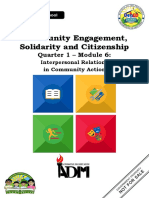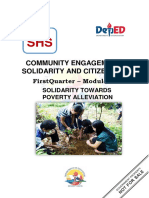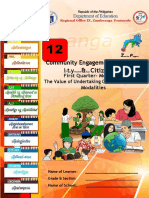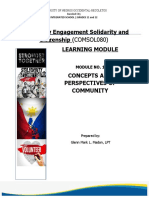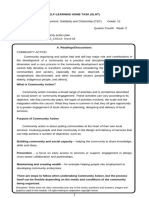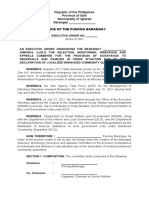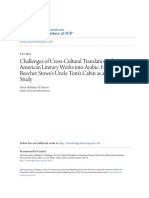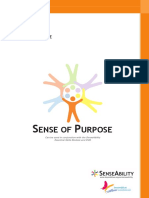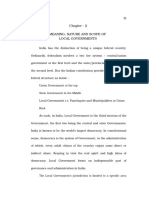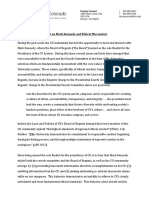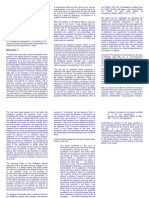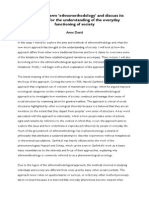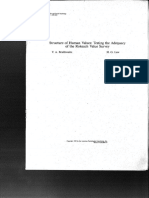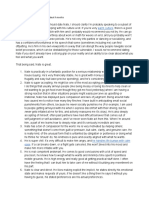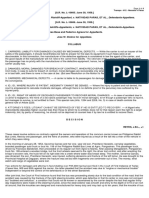SHS
COMMUNITY ENGAGEMENT,
SOLIDARITY AND CITIZENSHIP
Second Quarter – Module 5:
FORMULATE A COMMUNITY ACTION
i
�Community Engagement, Solidarity and Citizenship
Quarter 2 – Module 5: Formulate A Community Action
Republic Act 8293, section 176 states that: No copyright shall subsist in any work of
the Government of the Philippines. However, prior approval of the government
agency or office wherein the work is created shall be necessary for exploitation of
such work for profit. Such agency or office may, among other things, impose as a
condition the payment of royalties.
Borrowed materials (i.e., songs, stories, poems, pictures, photos, brand names,
trademarks, etc.) included in this book are owned by their respective copyright
holders. Every effort has been exerted to locate and seek permission to use these
materials from their respective copyright owners. The publisher and authors do not
represent nor claim ownership over them.
Regional Director: Gilbert T. Sadsad
Assistant Regional Director: Jessie L. Amin
Development Team of the Module
Writer: Alma Theresa D. Diaz
Evaluator: Raymund S. Briones
Editor: Divina M. Diaz, Ph.D.
Marita H. Mendoza
Illustrator:
Layout Artist: Edsel D. Doctama
ii
�INTRODUCTION
"Formulate a Community Action", is one of the competencies of Community
Engagement, Solidarity, and Citizenship, a course which comprises the knowledge,
skills and attitudes required for a HUMMS graduate to possess. This module contains
topics and activities related to the study on community action and its purposes and
issues as well discussions on the development and formulation of a community action
plan.
OBJECTIVES
Learning is fun and engaging! After
studying this module, you are expected to:
1. recognize the role of the youth in community action;
2. identify the major issues existing in the community;
3. formulate community action plan that will address the community issues.
VOCABULARY LIST
To prepare you on this module, you need to unlock
some concepts to give you a better understanding of
the topics to be studied. Below are some of the terms
relevant to your study.
COMMUNITY – from the Latin word communitas meaning “fellowship”. Its Latin
roots, communis, means common. Com translates to “with” or “together”; whereas
munire translates to “to strengthen”, “to fortify”, or “to defend”
1
�COMMUNITY ENGAGEMENT – refers to the process of working collaboratively with
and through groups of people affiliated by geographic proximity; special interest, or
similar situations to address issues affecting the well- being of those people
INSTITUTIONS – are established rules that ensure the regular and predictable
behavior of actors within a community.
INFORMAL INSTITUTIONS - are practices, norms, traditions, culture, conduct and
belief systems of a community.
SOLIDARITY – refers to the idea of unity or feeling of agreement among individuals
with common interest.
PRE-TEST Are you ready now? If so,
please answer the pre-test
below.
True or False. Write T if the statement is correct and F if it is wrong.
_____ 1. Community action are activities that is within the community.
_____ 2. Action Plan are the steps on how to implement an activity.
_____ 3. The Youth should not be part of a community action.
_____ 4. There is no solidarity during community action.
_____ 5. Resilience of the community is important so that it can support itself.
LEARNING ACTIVITIES
In the previous module, you learned about the
methodologies and approaches in community
action. In this module, you will be taught on
how to formulate a community action.
2
�COMMUNITY ACTION
Community organizing and action had and still has major role and contributions
in the development of a community as a practice and discipline. It is a constitutive
dimension and a core process in the community development and in social change.
We cannot fully develop or transform society without considering the organization of
small communities and sectors, especially the poor, deprived, oppressed, exploited,
marginalized, discriminated, and other excluded sectors (people with special needs,
elderly, indigenous people, and others).
What is Community Action?
Community action includes a broad range of activities and ii is sometimes described
as ‘social action' or ‘community engagement'. These activities can vary according to
its objective, role that community plays, the types of activities involved, the scale and
the integration within the council. What they have in common is that they all give
opportunity to a greater engagement of local citizens in planning, designing and
delivery of local services.
Purpose of Community Action
Community action is about putting communities at the heart of their own local services.
Involving people and their community in the design and delivery of services that can
help achieve a number of objectives, such as:
3
�Building community and social capacity – helping the community to share knowledge,
skills and ideas. BIG IDEA
There are steps to follow
Community resilience – helping the community when undertaking
Community Action, but the
to support itself. process itself can be flexible
depending on the needs and
conditions of the
Prevention – a focus on early access to
community being organized.
services or support, engagement in design,
cross-sector collaboration and partnerships.
Maintaining and creating wealth – for example helping people into employment or
developing community enterprises.
MAJOR ISSUES AFFECTING POOR AND MARGINALIZED COMMUNITIES
Causes of Poverty
—Low to moderate economic growth
—Slow poverty reduction growth
—Low employment and quality of work
—Lack of fully developed agriculture
—Inflation occurs when crisis happens
—Overpopulation
—High level of inequality in income
—Exposure to risks
4
�Marginalization
The process whereby something or someone is pushed to the edge of a group
and accorded lesser importance. This is predominantly a social phenomenon by
which a minority or sub-group is excluded and their needs or desires ignored.
- Immigrants, Refugees, and - Physically Disabled, or Mentally
Migrants ill people
- Women and Girls
- Incarcerated People (and their
- Victims of Human Trafficking
families)
- Mentally Ill
- People Released from Incarceration
- Children and Youth
- People of Low Socioeconomic Status
- People of Differing Sexual
- Unemployed.
Orientation (LGBT community)
- People of Low Socioeconomic Status
- People of Differing Religions
- Unemployed People
- Developmentally Delay...
- People of a Particular
- People of Differing Religions
Ethnicity/Country of Origin
- Developmentally Delayed,
- People with a Differing Political
Orientation
You learn now the very purpose of community
action from all the issues affecting our
communities. As a student, what do you think
are your role in community action?
5
� The Role of the Youth in Community Action
"KABATAAN ANG PAG-ASA NANG BAYAN"
Ways Youth can Change the World through Community
Development
Youth as Community Organizers - When youth is not engage by the government,
in a community organization, other community groups and non- profit can step in to
create youth as community organizers. Through training and empowerment they can
develop a unique powerful campaigns that will engage many people, including
children, youth, adults and families.
Youth and Government - Participation in regular and sustained government position,
roles and activities can allow youth community developers to change the world. Roles
should be rule voting and frequent, and focus on engaging diverse young people
Youth as Planners — Young people can participate as community planners in
community development work through education and training and equipped them of
skills and knowledge that they can impart among their peers, young people as well as
adults
Processes to undertake in Community action
A. Identification and Prioritization of issues, problems, and concerns.
B. Formulation of an action plan indicated in a comprehensible objectives,
methodologies or strategies, time frame/time duration, needed
resources, and responsible persons, committees, or groups.
C. Evaluation of the process.
6
�Important Things to Consider in Community Action
It is good to start with the basics. In the process of strengthening community
organization, it is better to first gain small successes. A systematic community must
have education and formation; a creative and sustainable community reflection-
action-reflection; a consistent and regular planning, implementation, monitoring, and
evaluation; an effective communication systems; a proper and organized research and
documentation; a well-managed resource mobilization; a continuous leadership
formation and development; and a sustained network, linkages, and solidarity work
with other groups can assist the community organization in the challenge of
sustainability. In other words, community organization must establish an
organizational culture.
COMMUNITY ACTION PLAN
What Is a Community Action Plan?
The community action plan is one of the participatory tools used to build the
capacity of community members in taking action in accordance with the problems,
needs, and potential of the community.
The community action plan is a road map for implementing community change
by clarifying what and how it will be done and who will do it. The plan describes what
the community wants to achieve, what activities are required during a specified
time/period, what resources (money, people and materials) are needed to be
successful.
7
� The community action plan should become a framework for implementing the
activities that are decided by the community itself. The focus is more on the process
of understanding and overcoming problems in order to rebuild the people's lives rather
than just physical development such as building houses, providing clean water or toilet
facilities. It is important to understand that the community should be the main actors
in preparing their own community action plan. Producing the action plan helps people
to take realistic and concrete steps toward participatory development planning in order
to improve not only sanitation and water system but what is essential in the community
development by bringing everyone together to think and discuss about resources and
group involvement, this tool increases awareness about the skills and resources
already available in the community.
General Principles of Community Action Plans
➢ It is a process for action; not a blueprint for future
development.
➢ The solution for problems comes from the
community itself, while the role of the facilitator is
more on formulating the problems in the community.
➢ It is not determined from outside the community but grows/emerges from the
affected community.
➢ Avoid activities such as lecturing or teaching the people; but concentrate more
on workshops as a form of discussion with the community.
➢ Guarantee that all relevant groups participate in the activities, particularly the
women and other community groups that are often forgotten.
8
� ➢ Facilitate input from all groups; do not allow one group or leader to dominate the
discussion.
➢ Remember that one issue might appear to be not very important for one group,
but is important for another group.
➢ Avoid too many pictures and text; it is better to absorb and remember several
points rather than make a long list.
➢ Use simple language and avoid difficult terms.
➢ Make the material as simple as possible.
The development and formulation of a community action plan consists of
several standard measures that are generally applicable. However, in practice, the
specific context and nature of community needs in a specific or chosen community
action plan will add uniqueness to those measures.
Stages in formulating a community action plan can be described as follows:
• Opening: Introduction and Socialization: This first stage intends to provide
a common understanding of the importance of having a good action plan, and
a common understanding of why an action plan is needed.
• Social and Environmental Mapping financing: This stage is meant to gain
an understanding of the latest conditions in the community life that is the social,
economic, as well as environmental conditions. By developing a map, the
community will be able to get a better picture of problems and priorities.
• Identifying the Problems, Needs, and Resource Potential: This
stage defines the problems that are actually faced by the community, the needs
9
� that must be fulfilled in order to overcome the problems, and the financial
resources available to accomplish the needs. This process of identification
should be done carefully in order to avoid becoming just a task of making a
“wish list”, and should be viewed as a process of understanding the current
situation and what must be done to overcome the situation as fast as possible.
• Determining the Priority in Problems and Needs: In this stage the problems
and needs are ranked by the community members according to their level of
urgency, their importance for the development of community life, and the
opportunity to overcome and to fulfil.
• Formulating the Choice of Strategy: In this stage, the strategy is developed
and the approach chosen that is the most feasible to be used in overcoming the
problems and fulfilling the needs on the priority list.
• Formulating the Choice of Action: In this stage, it is determined which action
has to be taken in implementing the chosen strategy and approach.
• Formulating the Implementation Plan: This stage is used to formulate a
schedule and the division of tasks in carrying out the action chosen.
• Formulating the Monitoring and Evaluation Plan: This stage is used to
formulate a plan and system of monitoring and evaluating the execution of
activities.
• Implementation, Monitoring and Evaluation: This final stage consists of
carrying out the action, and at the same time monitoring and evaluating.
10
�Considerations for Completing a Community Action Plan
The following points should be taken into consideration in completing a community
action plan:
• Partnerships among people. In order to accomplish the goals and objectives
in the plan, many people will have to be integrated and have to fully participate
in doing the work. It is important that the involved people develop good relations
and trust among each other.
• Budget. Financial resources are usually necessary to develop and carry out a
community action. Therefore, it is important to develop a budget that describes
the expenses for carrying out the action plan. What you include in the budget
should match the proposed strategies and activities.
• Close alignment with the community’s mission and vision. The vision that
was developed during the community assessment process reflects where the
community wants to be headed. The mission is the purpose of your group.
During the writing of the action plan, the writers work from the vision and the
mission to identify several major goals (priority or strategic) that must be
reached. These, in total, work toward the vision and the mission.
• A feasible plan does not have to be “perfect”. More important than a
“perfect” action plan is one that is feasible for the community partnership to
complete within a reasonable period of time. The action plan is a working
document that can be reviewed as the group implements it. It is a starting point
that people can continue to update and revise as community groups learn over
time and through their evaluation, how to accomplish their goals.
11
� How is your readings? Were you able to recognize
the role of the youth in community action? How
about doing an action plan? Let us see if you did
well in your studies. Do the practice tasks below.
Practice Task 1:
Identify at issues, problems, and concerns in your community. List them down
__________________________ __________________________
__________________________ __________________________
__________________________ __________________________
From the list you created choose the top three most priority and the 3 least
important. List them down.
MOST IMPORTANT LEAST IMPORTANT
__________________________ __________________________
__________________________ __________________________
__________________________ __________________________
Practice Task 2
From the most important issues identified, who do you think are the persons
that needs to be involved in the solution and what are the resources you need?
Issue Persons to be Involved Resourced Needed
1. ________________ ____________________ ___________________
2. ________________ ____________________ ___________________
3. ________________ ____________________ ___________________
12
�Practice Task 3
Below is a sample community action plan in tabular form. Fill in the box with
corresponding data. Some of the data are already provided.
Program/Project Development of Day Care Center facilities
Specific 1. Assessment of Day Care Center Facilities
Activities: 2. ____________________________________
3. ____________________________________
Specific Period of 1. June 1-30 2020 for the Assessment of Day Care
Time Center Facilities
2. July 1 to August 31, 2020 for
______________________.
3. ______________________
Expected Output At Least 85 % of the day care center building is repaired,
rebuilt, and maintained.
Responsible 1. Fathers of the day care students
Persons/ 2. _____________________________
Committees/ 3. _____________________________
Groups
1. Carpentry tools, and construction labor skills will be
Resources provided by the volunteer parents
Needed 2. ____________________________________
3. ____________________________________
13
� Good job! You are done with your
practice tasks. Now, answer the
post test. Let us see how far have
you gone in your studies.
POST TEST
A. IDENTIFICATION
Direction: Identify what the statement is about.
_____________ 1. The process whereby something or someone is pushed to the
edge of a group and accorded lesser importance
_____________ 2. Helping the community to share knowledge, skills and ideas.
_____________ 3. Young people can participate as community planners in community
development work.
_____________ 4. A broad range of activities and is sometimes described as ‘social
action' or ‘community engagement'.
_____________ 5. Helping the community to support itself.
B. MATCHING TYPE
Match Column A with the appropriate description on column B.
14
� Column A Column B
1. Community Action Plan A. One of the participatory tools used to build the
capacity of community members in taking action in
2. Determining the Priority in accordance with the problems, needs, and potential of
Problems and Needs the community.
3. Partnership among people B. Problems and needs are ranked according to their
level of urgency, their importance for the development
4. Budget of community life, and the opportunity to overcome
and to fulfil.
5. Formulating the Choice
of Strategy C. Financial resources are usually necessary to
develop and carry out a community action
D. People will have to be integrated and have to fully
participate in doing the work
E. The strategy is developed and the approach chosen
that is the most feasible to be used in overcoming
the problems and fulfilling the needs on the priority
list.
ASSIGNMENT
Using the sample table above, create a short community action plan.
The project and activities should be anchored in the observed issues and problems in
the community.
Program/Project
Specific Activities:
Specific Period of Time
Expected Output
Responsible Persons/
Committees/Groups
Resources Needed
15
�ANSWER KEY
Pre-Test
1. True
2. True
3. False
4. False
5. True
Post Test
A. Identification
1. Marginalization
2. Building community and social capacity
3. Youth as Planners
4. Community Action
5. Community Resilience
B. Matching Type
1. A
2. B
3. D
4. C
5. E
16
�REFERENCES
BIBLIOGRAPHY
Community Engagement, Solidarity, and Citizenship by DIWA Publishing.
Accessed: June 18, 2020
Online Sources:
https://prezi.com/p/flzdcxkdplfk/purpose-of-community-action/
Accessed: June 25, 2020
https://sswm.info/sswm-solutions-bop-markets/improving-water-and-sanitation-
services-provided-public-institutions-1/community-action-
plan#:~:text=The%20plan%20describes%20what%20the,decided%20by%20the%20
community%20itself.
Accessed: July 10, 2020
Cover photo credit: Melody D. Legaspi (Rizal Integrated National School, Sorsogon City)
17






























